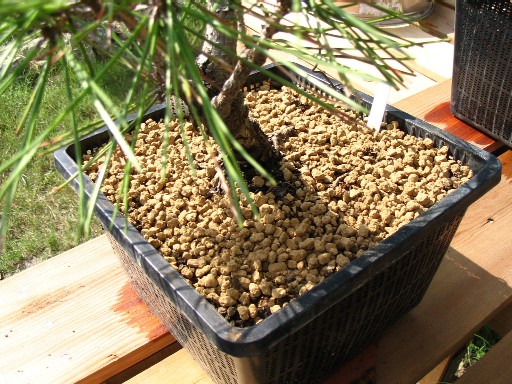Akadama on:
[Wikipedia]
[Google]
[Amazon]

 is a naturally occurring, granular
is a naturally occurring, granular

 is a naturally occurring, granular
is a naturally occurring, granular clay
Clay is a type of fine-grained natural soil material containing clay minerals (hydrous aluminium phyllosilicates, e.g. kaolinite, ). Most pure clay minerals are white or light-coloured, but natural clays show a variety of colours from impuriti ...
-like mineral used as soil
Soil, also commonly referred to as earth, is a mixture of organic matter, minerals, gases, water, and organisms that together support the life of plants and soil organisms. Some scientific definitions distinguish dirt from ''soil'' by re ...
for bonsai trees and other container-grown plants. It is surface-mined, immediately sifted and bagged, and supplied in various grades; the deeper-mined grade are somewhat harder and more useful in horticulture than the softer, shallow-mined grades. ''Akadama'' may also act as one component of growing medium when combined with other elements such as sand, composted bark, peat, or crushed lava. The color darkens when moist which can help the grower determine when to water a tree.
While ''akadama'' is more costly than alternative soil components, it is prized by many growers for its ability to retain water and nutrients while still providing porosity and free drainage
Drainage is the natural or artificial removal of a surface's water and sub-surface water from an area with excess water. The internal drainage of most agricultural soils can prevent severe waterlogging (anaerobic conditions that harm root gro ...
. For all of its qualities, many bonsai growers consider the cost of akadama prohibitive or unnecessary. Still other growers claim that when subjected to cold and wet climates, the granules progressively break down into smaller particles that inhibit drainage, an unwanted characteristic of bonsai soil. This problem can be avoided either by incorporating sand or grit in the soil mix, or by using the deeper-mined, harder grades.
Origin
Due to volcanic activity, Japan enjoys rich volcanic resources. After volcanic eruptions, volcanic rocks and pumice accumulate near the volcano. Several horticultural products based on these materials have been developed in Japan, two of which are the ''Akadama'' and ''kanuma'' soils.Size and components
Components includesilicon dioxide
Silicon dioxide, also known as silica, is an oxide of silicon with the chemical formula , commonly found in nature as quartz. In many parts of the world, silica is the major constituent of sand. Silica is one of the most complex and abundan ...
SiO2 42.7%, calcium oxide
Calcium oxide (formula: Ca O), commonly known as quicklime or burnt lime, is a widely used chemical compound. It is a white, caustic, alkaline, crystalline solid at room temperature. The broadly used term '' lime'' connotes calcium-containing ...
CaO 0.98%, magnesium oxide
Magnesium oxide (MgO), or magnesia, is a white hygroscopic solid mineral that occurs naturally as periclase and is a source of magnesium (see also oxide). It has an empirical formula of MgO and consists of a lattice of Mg2+ ions and O2− ions ...
MgO 2.5%, manganese oxide Manganese oxide is any of a variety of manganese oxides and hydroxides.Wells A.F. (1984) ''Structural inorganic chemistry'' 5th edition Oxford Science Publications, . These include
* Manganese(II) oxide, MnO
* Manganese(II,III) oxide, Mn3O4
* Man ...
MnO 0.15%, iron oxide
An iron oxide is a chemical compound composed of iron and oxygen. Several iron oxides are recognized. Often they are non-stoichiometric. Ferric oxyhydroxides are a related class of compounds, perhaps the best known of which is rust.
Iron ...
Fe2O3 8.4%, and aluminium oxide
Aluminium oxide (or aluminium(III) oxide) is a chemical compound of aluminium and oxygen with the chemical formula . It is the most commonly occurring of several Aluminium oxide (compounds), aluminium oxides, and specifically identified as alum ...
Al2O3 25.1%.
Akadama has a pH of 6.9 and conductivity of 0.052 ms/ cm.
Uses
Akadama is used in the cultivation of plants. It can be used alone or mixed in as an amendment to other soil substrates such as lava rock, pumice, stone, peat moss, bark, etc. It is supplied in various sizes including "Shohin" (less than 1/16 inch), "Small" (1/16 inch to 1/4 inch), and "Medium" (1/4 inch to 1/2 inch). All sizes are suitable for many sorts of potted plants, but in particular, shohin or small is the preferred choice for cactus and succulent plants.References
{{Reflist Bonsai Plant nutrition Types of soil